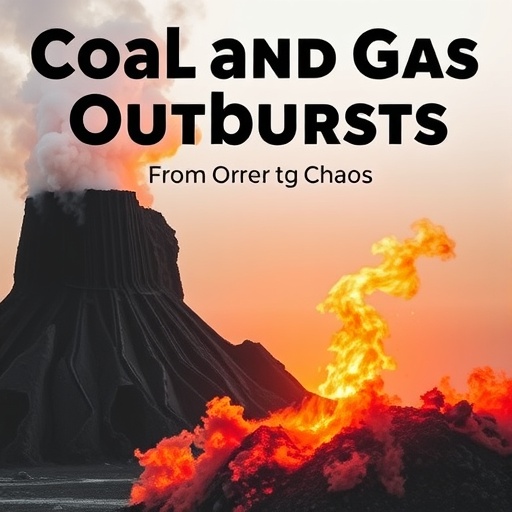The dynamics of coal-and-gas outbursts represent a critical intersection of geological science and safety engineering, particularly in the context of coal mining. Recent explorations into this phenomenon have highlighted the intricate interplay between geophysical forces and the characteristics of coal seams. In a groundbreaking study by Lei, Wen, and Wang, published in Nature Resource Research, the authors delve into the mechanisms underlying these outbursts, revealing a complex landscape where order evolves into chaos.
At the onset of their research, the authors underscore the significance of understanding coal-and-gas outbursts not only from a scientific viewpoint but also from a practical standpoint. Such events pose a substantial risk to mining operations, often leading to catastrophic consequences if left unchecked. By employing sophisticated coupling analysis methods, the researchers sought to unravel the precise interactions within the coal seam environment that can trigger an outburst. Through their rigorous field studies, they illuminated the processes that shift from stable states to chaotic behavior, suggesting a deeper, fundamental dynamic at play.
One of the principal findings of the study is that outbursts are not random occurrences but rather the result of specific geomechanical conditions combined with gas pressure factors. Lei and colleagues elevate the understanding of these phenomena by presenting a comprehensive model that integrates variables such as coal structure, gas content, and external stress factors. This model not only aids in predicting when an outburst may occur but also forms the basis for developing preventative measures aimed at safeguarding miners.
Furthermore, the research highlights the importance of field data in validating theoretical models. By analyzing various field observations, the authors were able to establish a direct correlation between gas accumulation dynamics and the physical parameters of coal seams. This correlation inadvertently points to the inadequacy of previous models that failed to account for the multi-faceted nature of coal-and-gas interactions. The broad implications of their findings stress the necessity for ongoing data collection in real mining environments and the potential for enhancing safety protocols through empirical research.
In their examination of how orderly conditions can spiral into chaos, Lei et al. discuss the role of critical thresholds in the dynamics of outbursts. When certain thresholds are crossed—whether through stress accumulation, gas pressure spikes, or structural fatigue—there is a marked transition from a stable equilibrium to chaotic behavior. This transition, often abrupt and unpredictable, underscores the inherent risks that miners face, making predictive modeling essential for risk management in coal mining operations.
The researchers employed a multidisciplinary approach, drawing insights from physics, geology, and mathematics. This methodological diversity was crucial in comprehensively addressing the complexities of coal-and-gas interactions. By fostering collaboration among experts in these fields, the authors were able to enhance both the analytical depth and the practical applicability of their conclusions, showcasing the advantages of interdisciplinary collaboration in tackling real-world problems.
Additionally, the implications of these findings extend beyond immediate safety concerns. Understanding the intricate dynamics of coal-and-gas outbursts directly impacts the economic viability of coal mining operations. With accurate predictive tools, mining companies can implement better resource management strategies, reducing downtime and preventing costly accidents. Such advancements could not only enhance operational efficiency but also improve the sustainability of coal mining practices in an era increasingly focused on environmental responsibility.
Moreover, the study’s findings resonate with larger discussions regarding the future of fossil fuel industries in a world increasingly leaning toward renewable energy sources. As such, this research may serve as a precursor to developing innovative extraction techniques that not only optimize safety but also minimize environmental impact, thus contributing to a more sustainable model of resource extraction.
As part of their analysis, the authors also consider the historical context of coal-and-gas outbursts research. They trace the evolution of theoretical models from simplistic foundations to more elaborate structures that reflect the complexities observed in field data. This historical perspective not only enriches the current understanding of outbursts but also serves as a cautionary tale about reliance on outdated models and assumptions. It invites future researchers to remain vigilant in ensuring that emerging theories are constantly validated against real-world observations.
Looking ahead, Lei, Wen, and Wang suggest several avenues for further research, emphasizing the need for more nuanced studies that account for the variability of environmental conditions. This includes the impact of climate change on geological formations and how such changes may influence gas behavior within coal seams. By identifying these additional variables, future studies can develop even more robust models capable of predicting outburst events, thus contributing to the ongoing evolution of best practices in the mining sector.
In conclusion, the research presented by Lei et al. marks a pivotal advancement in the understanding of coal-and-gas outbursts. The authors adeptly bridge theoretical concepts with practical applications, laying down a comprehensive framework that facilitates both deeper academic inquiry and enhanced safety measures in mining operations. As the study resonates with the urgent need for responsible resource extraction and management, it stands as a testament to the critical role of interdisciplinary collaboration in addressing complex environmental challenges faced by the mining industry today.
By sparking dialogue among scientists, engineers, and policymakers, the insights gained from this research are poised to catalyze significant advancements in the field of coal mining safety, ultimately guiding efforts to foster a more sustainable and responsible future for fossil fuel extraction.
Subject of Research: Coal-and-gas outbursts in mining operations
Article Title: Dynamics of Coal-and-Gas Outbursts: Field Coupling Analysis and Evolution from Order to Chaos
Article References:
Lei, Y., Wen, Z., Wang, L. et al. Dynamics of Coal-and-Gas Outbursts: Field Coupling Analysis and Evolution from Order to Chaos. Nat Resour Res (2025). https://doi.org/10.1007/s11053-025-10532-8
Image Credits: AI Generated
DOI: 10.1007/s11053-025-10532-8
Keywords: Coal mining, gas outbursts, safety engineering, environmental geology, predictive modeling, interdisciplinary research




